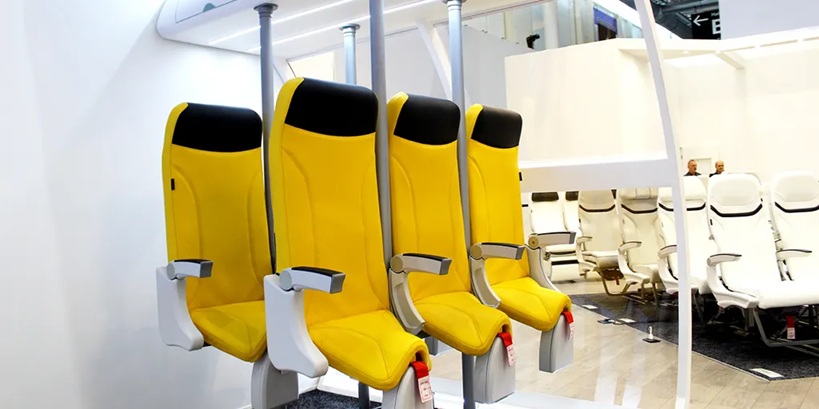In the ever-evolving world of air travel, where every square inch of space is monetized and efficiency is king, a new trend is generating significant buzz: standing seats. Budget airlines, always on the hunt for innovative ways to cut costs and boost passenger capacity, are reportedly gearing up to introduce these unconventional seating arrangements as early as 2026.
The concept, long discussed and even tested in prototypes, may finally be taking off—literally.
What Are Standing Seats?
Standing seats, sometimes dubbed “vertical seats” or “saddle seats,” are a radical departure from traditional airline seating. Passengers would not be entirely standing, per se, but rather perched on a high, narrow, bicycle-like seat with support for the lower back and safety harnesses in lieu of conventional seatbelts.
This concept aims to mimic the posture of standing while still providing enough support to meet safety standards. The goal is to maximize space by reducing the seat pitch (the distance from one seat to the same point on the seat in front of it) to as little as 23 inches, compared to the 28–32 inches found in most economy cabins.
Who’s Leading the Charge?
European budget carriers such as Ryanair and Wizz Air have previously expressed interest in the idea. Ryanair’s CEO, Michael O’Leary, is infamous for his provocative proposals—ranging from pay-to-use toilets to standing room on short-haul flights. While many of these ideas have been shelved or ridiculed, industry insiders report that some are now being revisited with renewed seriousness.
In 2023, Aviointeriors, an Italian aircraft seat manufacturer, unveiled updated versions of its SkyRider standing seat model at the Aircraft Interiors Expo in Hamburg. These new designs claimed to meet safety certification standards while offering increased density for airlines and, presumably, lower fares for passengers.
Now, reports suggest that regulatory conversations with the European Union Aviation Safety Agency (EASA) and other national regulators are progressing, raising the possibility of trial implementations by 2026.
The Case For Standing Seats
Supporters of standing seats argue that they could democratize air travel by making it even more affordable. With more seats squeezed into the same fuselage, airlines could spread costs across a larger passenger base, theoretically driving down ticket prices.
For ultra-short-haul flights—those under 90 minutes—many passengers might be willing to trade comfort for cost. After all, standing on a subway or commuter train for an hour is routine in many cities. Why should air travel be any different?
Furthermore, proponents note that lower seat weight and reduced materials could also translate into fuel savings and smaller environmental footprints.
Safety and Comfort Concerns
Despite the buzz, the proposal has met with significant skepticism. Safety remains a major concern. Aviation is one of the most tightly regulated industries, and every seat must be certified to withstand severe crash forces. The idea of passengers being upright—or perched—during takeoff, landing, and turbulence triggers alarm bells for many aviation experts.
Comfort is another sticking point. Critics argue that even short flights could become unbearable if passengers are restricted to upright “saddle” positions without adequate support, legroom, or freedom to shift posture. This could exacerbate circulatory problems, particularly for older travelers or those with health conditions.
Then there’s the matter of optics. Airlines risk sparking backlash by appearing to treat passengers more like cargo than customers. The optics of cramming more people into tighter spaces may fuel already simmering tensions about how budget airlines treat their passengers.
Regulatory Hurdles
While the concept might sound appealing to bean counters and bottom lines, it faces significant regulatory hurdles. Both the European Union Aviation Safety Agency (EASA) and the U.S. Federal Aviation Administration (FAA) have strict guidelines regarding seat design, passenger protection, and crash survivability.
Aviointeriors and other proponents must prove not only that standing seats meet these guidelines, but also that passengers can evacuate an aircraft within the required 90 seconds during emergencies. Previous versions of the SkyRider were rejected for failing to meet these standards, although updated designs claim to have addressed those deficiencies.
Even if regulators give a green light, airlines may face public relations challenges and consumer hesitation, especially during initial rollout phases.
What This Means for Travelers
If standing seats do become reality, they are likely to be optional add-ons, much like today’s “basic economy” fares. Passengers may be given the choice: pay rock-bottom prices to perch for a 45-minute flight, or fork out a little more for a traditional seat.
For budget travelers and frequent flyers on short routes, the appeal may be significant. Others may avoid these seats entirely, viewing them as a bridge too far in the relentless quest to cut costs.
It also sets the stage for a deeper philosophical debate about the nature of modern air travel. Should airlines prioritize comfort, dignity, and passenger experience? Or is affordability the ultimate goal, even if it comes with trade-offs?
The Bottom Line
Standing seats are no longer just a punchline or a wild concept for speculative trade shows. With serious engineering, regulatory engagement, and economic incentives driving the discussion, they might become a reality within the next year or two.
Whether you see them as an innovation or an indignity, one thing is clear: the future of budget air travel is likely to be even more compact, efficient, and cost-conscious than ever before.
Would you stand to save? Come 2026, you just might have the chance to find out.
